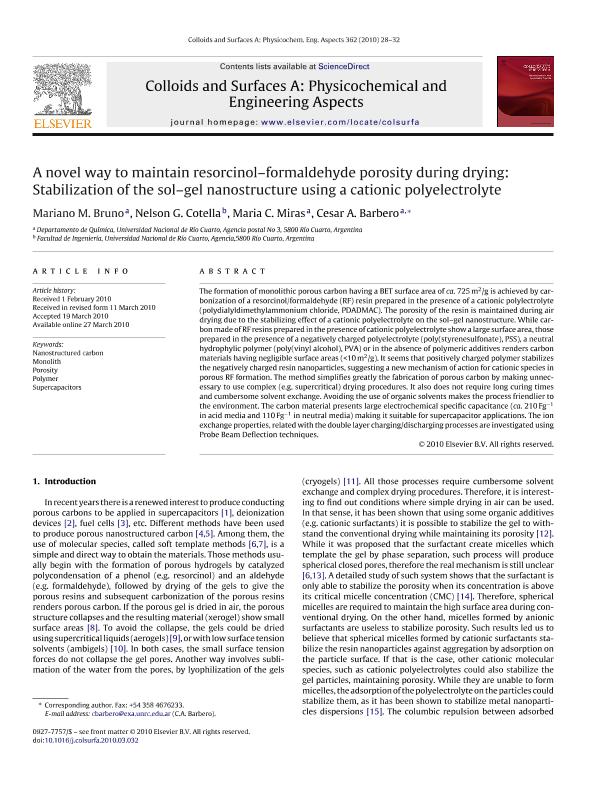Mostrar el registro sencillo del ítem
dc.contributor.author
Bruno, Mariano Martín

dc.contributor.author
Cotella, Nelson Gustavo

dc.contributor.author
Miras, Maria Cristina

dc.contributor.author
Barbero, César Alfredo

dc.date.available
2021-05-06T03:52:11Z
dc.date.issued
2010-06
dc.identifier.citation
Bruno, Mariano Martín; Cotella, Nelson Gustavo; Miras, Maria Cristina; Barbero, César Alfredo; A novel way to maintain resorcinol-formaldehyde porosity during drying: Stabilization of the sol-gel nanostructure using a cationic polyelectrolyte; Elsevier Science; Colloids and Surfaces A: Physicochemical and Engineering Aspects; 362; 1-3; 6-2010; 28-32
dc.identifier.issn
0927-7757
dc.identifier.uri
http://hdl.handle.net/11336/131469
dc.description.abstract
The formation of monolithic porous carbon having a BET surface area of ca. 725m2/g is achieved by carbonization of a resorcinol/formaldehyde (RF) resin prepared in the presence of a cationic polylectrolyte (polydialyldimethylammonium chloride, PDADMAC). The porosity of the resin is maintained during air drying due to the stabilizing effect of a cationic polyelectrolyte on the sol-gel nanostructure. While carbon made of RF resins prepared in the presence of cationic polyelectrolyte show a large surface area, those prepared in the presence of a negatively charged polyelectrolyte (poly(styrenesulfonate), PSS), a neutral hydrophylic polymer (poly(vinyl alcohol), PVA) or in the absence of polymeric additives renders carbon materials having negligible surface areas (<10m2/g). It seems that positively charged polymer stabilizes the negatively charged resin nanoparticles, suggesting a new mechanism of action for cationic species in porous RF formation. The method simplifies greatly the fabrication of porous carbon by making unnecessary to use complex (e.g. supercritical) drying procedures. It also does not require long curing times and cumbersome solvent exchange. Avoiding the use of organic solvents makes the process friendlier to the environment. The carbon material presents large electrochemical specific capacitance (ca. 210Fg-1 in acid media and 110Fg-1 in neutral media) making it suitable for supercapacitor applications. The ion exchange properties, related with the double layer charging/discharging processes are investigated using Probe Beam Deflection techniques.
dc.format
application/pdf
dc.language.iso
eng
dc.publisher
Elsevier Science

dc.rights
info:eu-repo/semantics/openAccess
dc.rights.uri
https://creativecommons.org/licenses/by-nc-sa/2.5/ar/
dc.subject
MONOLITH
dc.subject
NANOSTRUCTURED CARBON
dc.subject
POLYMER
dc.subject
POROSITY
dc.subject
SUPERCAPACITORS
dc.subject.classification
Físico-Química, Ciencia de los Polímeros, Electroquímica

dc.subject.classification
Ciencias Químicas

dc.subject.classification
CIENCIAS NATURALES Y EXACTAS

dc.title
A novel way to maintain resorcinol-formaldehyde porosity during drying: Stabilization of the sol-gel nanostructure using a cationic polyelectrolyte
dc.type
info:eu-repo/semantics/article
dc.type
info:ar-repo/semantics/artículo
dc.type
info:eu-repo/semantics/publishedVersion
dc.date.updated
2021-04-28T20:13:20Z
dc.journal.volume
362
dc.journal.number
1-3
dc.journal.pagination
28-32
dc.journal.pais
Países Bajos

dc.journal.ciudad
Amsterdam
dc.description.fil
Fil: Bruno, Mariano Martín. Universidad Nacional de Río Cuarto. Facultad de Ciencias Exactas Fisicoquímicas y Naturales. Departamento de Química; Argentina. Consejo Nacional de Investigaciones Científicas y Técnicas. Centro Científico Tecnológico Conicet - Córdoba; Argentina
dc.description.fil
Fil: Cotella, Nelson Gustavo. Universidad Nacional de Río Cuarto. Facultad de Ingeniería; Argentina
dc.description.fil
Fil: Miras, Maria Cristina. Universidad Nacional de Río Cuarto. Facultad de Ciencias Exactas Fisicoquímicas y Naturales. Departamento de Química; Argentina
dc.description.fil
Fil: Barbero, César Alfredo. Universidad Nacional de Río Cuarto. Facultad de Ciencias Exactas Fisicoquímicas y Naturales. Departamento de Química; Argentina. Consejo Nacional de Investigaciones Científicas y Técnicas. Centro Científico Tecnológico Conicet - Córdoba; Argentina
dc.journal.title
Colloids and Surfaces A: Physicochemical and Engineering Aspects

dc.relation.alternativeid
info:eu-repo/semantics/altIdentifier/url/https://www.sciencedirect.com/science/article/pii/S0927775710002062
dc.relation.alternativeid
info:eu-repo/semantics/altIdentifier/doi/https://doi.org/10.1016/j.colsurfa.2010.03.032
Archivos asociados
